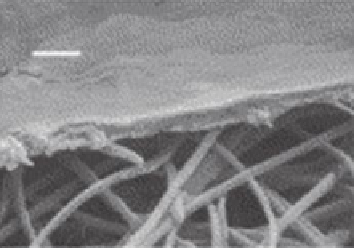Environmental Engineering Reference
In-Depth Information
piece of work, antimicrobial activity of a nylon 6 nanoiber membrane was found to
increase with
N
-halamine additives namely, chlorinated 5,5-dimethylhydantoin, chlori-
nated 2,2,5,5-tetramethyl imidozalidin-4-one, and chlorinated 3-dodecyl-5,5-dimethylhy-
dantoin. The growth of microbes was inhibited in the presence of the additives.
34
Yoon et al. demonstrated a system consisting of three tiers. A “nonporous” hydrophilic
coating of chitosan constitutes the irst layer, an electrospun PAN nanoibrous support
as the second layer, and a nonwoven polyethylene terephthalate microibrous substrate.
35
Figure 23.5 shows the fabrication schematic of the three-tier system. PAN is used since it
is resistant to most solvents, and chitosan has been used for antifouling enhancement of
iltration membranes owing to its insolubility in neutral pH conditions.
36
Other than quaternary ammonium salts, silver ions and silver compounds have long
been recognized as important antimicrobial agents. Currently, silver is extensively used
as silver nanoparticles (Ag NPs) due to its increased surface area.
37
Ag NPs can be incor-
porated onto the nanoibers by several methods. Ag NPs can be blended with polymer
solution and then electrospun. This results in the embedding of Ag NPs inside the poly-
mer matrix, which reduces the antimicrobial activity. Another method is to electrospray
Ag NPs onto the iber membrane. The most effective method to incorporate Ag NPs is by
growing nanoparticles on the iber surface. This can be achieved by mixing a silver salt
with the polymer solution and then electrospinning the mixture. The composite iber mat
can be subjected to heat treatment, UV irradiation, or photoreduction for reducing silver
ions to Ag NPs.
38,39
Various researchers have shown the applicability of Ag NP-incorpo-
rated polymeric nanoibers in antimicrobial studies. McCord and coworkers showed that
Ag/PAN hybrid nanofibers prepared by atmospheric plasma treatment and electrospin-
ning exhibit slow and long-lasting silver ion release, which provided robust antibacterial
activity against both gram-positive
Bacillus cereus
and gram-negative
E. coli
microorgan-
isms.
40
Likewise, silver-impregnated nanoibers have been prepared with different poly-
mers such as PAN, PVA, gelatin, poly(lysine glycolic acid), polylactide, and nylon 6, and
tested their antimicrobial activity toward different bacteria.
41-44
Figure 23.6 shows the transmission electron microscopic (TEM) images of Ag NP
prepared
in situ
on methacrylated PVA, PVA/dextran, and PVA/methyl cellulose nano-
ibers. It is clear that the nanoparticles are distributed uniformly over the ibers.
43
In
another approach, both an antibacterial effect and dye degradation was coupled to a
(a)
(b)
Nonwoven polyester
substrate
PAN e-spun layer
(10 wt% solution)
PAN e-spun layer
(4 wt% solution)
Chitosan/
PEG-g-chitosan
coating
2 µm
FIGURE 23.5
(a) Fabrication schematics of the electrospun scaffold with a coating layer. (b) Fractured composite membrane
containing PAN nanoibrous scaffold (with 4 + 12 wt% sequential electrospinning) and chitosan coating. (From
Yoon, K. et al.,
Polymer
, 47, 2434, 2006.)


